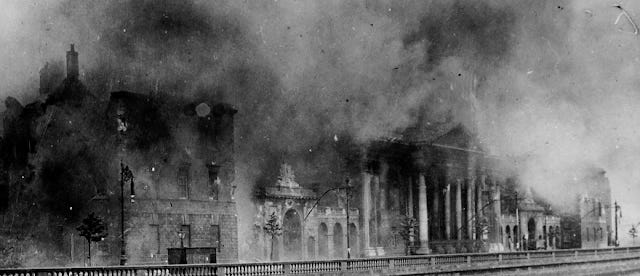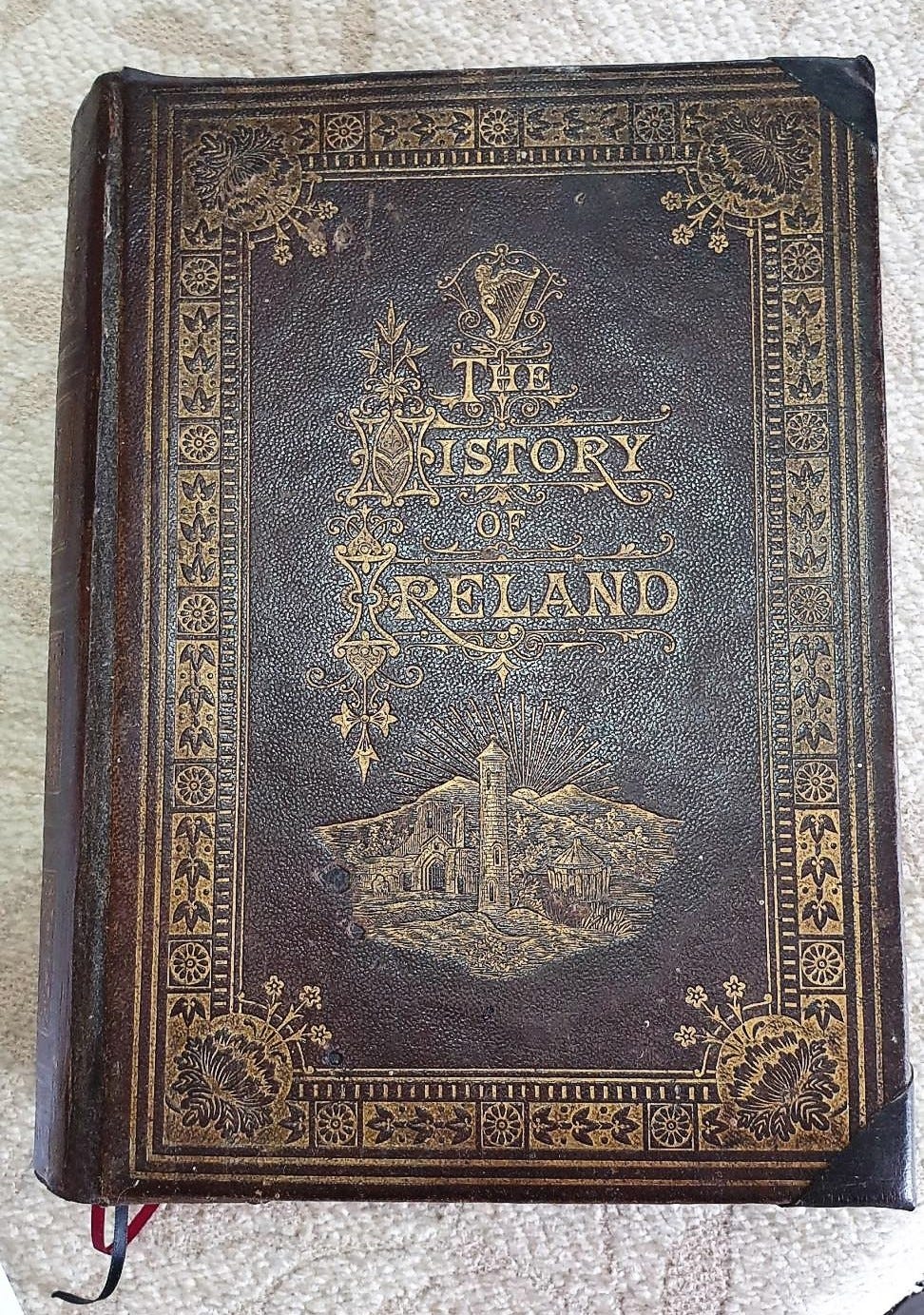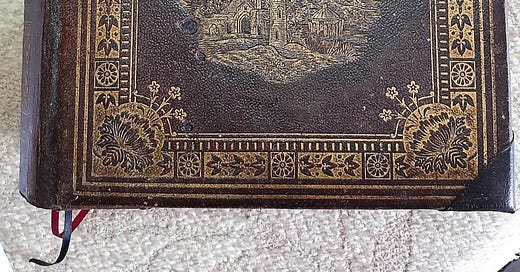A version of this article was published on the Ryan DNA Project website.
Since 2018, when I took a DNA test that suggested I had strong Irish roots, I have been researching my Irish family history. These days, DNA tests are easy and cheap to do. Just spit in a tube or get a cheek swabbed, and then send it to one of the many genealogy companies. Ancestry.com’s results showed that I’m Irish, Scottish, English and Polish.
Only scraps of information were known initially about our Irish family history. The older generations of our family have been told in the past that they would not have much luck finding information on the family. The reason was that the Ryans were Catholics, and Irish Catholics were generally not well educated until relatively recently (after 1800). Most also did not own any land - they usually leased property for their farms if they could afford it. On top of that, Ryan families forfeited their hereditary lands in the 1641 rebellion of the Catholic Confederacy [1].
There is an old Irish saying, “One could hardly throw a stone down a street in Tipperary without hitting a Ryan” [2]. To distinguish themselves, Ryan families often had nicknames that took the form of a double-barreled version of the surname (e.g. Ryan Black or Ryan Giant), but they were often not recorded in the records. There are over 500 known Ryan nicknames [3]. Unfortunately, successive wars have also resulted in the loss of many records, and any remaining documents are usually left in bad condition. In 1922, at the beginning of the Irish Civil War, a massive blast was caused by the shelling of the Public Records Office, the Four Courts in Dublin, losing many documents, including the Census records of 1821, 1831, 1841 and 1851 [4].

My DNA test piqued my interest in our family history. I shared my results online, showing a high amount of Irish blood, and a friend asked if I wanted help finding my Irish past. I lacked knowledge about my family history, so I didn’t know which family members came from Ireland to New Zealand and on what dates. I soon learned of two family books about our history somewhere within the family. After hunting them down, I found that one primarily dealt with the Ryan (Irish) side, The Ryan Family Reunion 2005, and the other focused on the Kurowski (Polish) side, The Kurowski Family In New Zealand 1876-1990.
I picked up a copy of “The Ryan Family Reunion 2005” book and started to learn about my forebears. The book talks about my great-great-great (GGG) grandparents Jeremiah Ryan and Mary Hayes leaving Ireland in 1875 and coming to New Zealand with their children to settle in Marton and then to Whanganui, New Zealand. These facts were my starting point as very little information about the Ryan family was known before coming to NZ.
Lower Hutt City Council website has the “Petone Settlers Data” database [5]. I found out from this database that Jeremiah and Mary Ryan left England on the 10th of February 1875 and arrived on the 22nd of May 1875 in Wellington, New Zealand, with three of their children. They soon moved to Marton, although their son Martin Francis Ryan, my GG grandfather, stayed in Ireland to study and look after his grandmother.
Martin Ryan is listed in the Petone Settlers Data records, but I noticed that his name was listed as both Martin and “Nate”. I soon found out a lot of the information from the database didn’t match the original immigration records I had found at FamilySearch.org and Archives NZ. The lesson here was always to check data against the original documents! About eighteen months after I saw these discrepancies, I discovered Martin’s profile had been merged with another person in the database called Kate Ryan. There was no hidden record where Martin used the name “Nate”. The transcriber must have misread. I have reported this mixup to Tricia Meehan, a History Specialist at the Petone Community Library. She says that the Petone Settlers Data database is unable to be updated online, but the Council has added the corrections to their hard copy. From these records, I learned that on the 29th of December 1883, Martin left England - alone it seems - and arrived in Wellington on the 17th of February 1884.

I was fortunate that I had not just one but three townlands listed in The Ryan Family Reunion 2005 to start my Irish research with - Drumwood, Chadville and Glassdrum. A townland is the smallest territorial division of land. I see many people online searching for the Ryans in their family history, where they don’t even have a parish or county name. It seems common not to list details such as townlands or parishes in records created in the country they emigrated to. Presumably, that level of detail was not seen as pertinent or useful enough to be a requirement.
Michael Ryan and Bridget Bourke were listed as Jeremiah’s parents on his death certificate. Martin Hayes and Mary Fleming were listed on his wife Mary’s death certificate as her parents. I was lucky that these were New Zealand death certificates, as Irish civil death records only started listing parents’ names in 2005! I soon learned that, even with this data, it would be hard work to know more about the Ryan family’s past.
As listed on Mary Hayes’s death certificate, the mother’s name Mary Fleming was wrong. It turns out her correct name was Johanna Fleming, which is known in The Ryan Family Reunion 2005 book. Whoever wrote the details for the death certificate may have been confused by Johanna’s sister’s or mother’s name.
With the various New Zealand records listing different ages at different times for Jeremiah, his potential birth year was between about 1827 and 1840. The year range could have been between 1824 and 1844 when adding the margin of error (±10). Mary also had a broad range of dates when she could have been born. It didn’t help that the Catholic Solohead Parish (where Drumwood is located) baptism records stopped between the 30th of April 1828 and the 25th of February 1837. On top of this, Irish names could be spelled in many different ways and had common nicknames.
For example, Jeremiah’s name in the records varied wildly - his name was recorded as Dimitrius, Jerry, and Dermot, all alternative spellings for Jeremiah. In this case, it seems Jeremiah also had a nickname of Joseph that he used for some NZ records.
Before 1850, people spelled townlands in totally different ways in letters, records or newspapers. For example,
Drumwood: Coill an Droma, Drum Wood, Dromwood, Dreemwood.
Chadville: Shadville, Chadvil.
Glassdrum: Glashdrum, Glasdrum, Clashdrum.
My suggestion is to record all alternative names!
Thankfully, I found all the children of Jeremiah and Mary through a mixture of church baptism and civil birth records.
For each of the children’s birthdays, I picked the earliest date from either the baptism or civil record:
The 22nd of October 1865 - Martin Ryan. Drumwood.
The 15th of November 1868 - Bridget Ryan. Drumwood.
The 10th of February 1871 - Honora Ryan. Drumwood.
The 14th of December 1873 - Thomas Ryan. Clonganhue.
None of the children likely knew their actual birthdates, and most recorded birth dates were out by a few years. Martin Ryan used his civil birth record date of the 25th of October 1865. Yes, Baptism dates can come before their Civil birth date records. Baptism was usually done right away as infant death rates were high at the time. Civil Records could take weeks, and by then, the parents may have forgotten the exact birth date of the child.
I discovered two more children in the records who were not mentioned in The Ryan Family Reunion 2005 book:
The 3rd of December 1862 - John Ryan. Moanmore.
The 17th of June 1864 - John Ryan. Moanmore or Drumwood (The baptism and the civil record gave different addresses)
As can be seen from the dates, these two John Ryans were the first children of Jeremiah and Mary. Close family members may have assisted in the first births - the births could have happened elsewhere from home. This might be why both Moanmore and Drumwood were mentioned as residences in the records for John Ryan. Both Bourkes and Ryans lived in Moanmore, and Jeremiah’s aunts/uncles or grandparents likely lived there. Moanmore is approximately an hour’s walk from Drumwood, using the Google Maps directions feature.
The unfortunate reason the family calls both of their first two sons John is that the elder John likely would have died before the second John was born. The name must have had some special significance because of their reuse of the name for their second son - who also sadly passed away, aged six months. A traditional Irish custom was for a name of significant importance to the family to be used again if a child had passed away - they would then keep using that name even if the first child lived for several years and then passed away.
I had been unable to find any record of a Michael Ryan marrying a Bridget Bourke, and there was also a lack of baptism records with those names as parents. Something was not right. In Ireland, naming rules were customarily followed - and the firstborn son was usually named after his father’s father. If we apply this rule to Jeremiah, it appears that Jeremiah’s death record was incorrect, and his father should have been named John Ryan rather than Michael.
It was a tradition for the husband to marry in the wife’s parish, and after the wedding, the groom moved to the wife’s parish. I found a Mary Hayes living in Drumwood, and therefore it is likely that Jeremiah would have moved to live in her parish.
There has been some confusion with the other Ryans at Drumwood. Contact with the historian John Kelly from Chadville had suggested our Ryans were the Ryan Darbys. On their 2010 trip to Tipperary, Ireland, family members (both grandchildren of Martin Francis Ryan) met up with Darby Ryan, who goes by Jerry, who showed them his family graves. I have mapped out plenty of the Darby family, but despite the suggestion from John, no link to our family has yet been found. It doesn’t help that some of the Darby Ryans had similar ages and names to our Ryans. However, it could be that the families were cousins.

A breakthrough was discovered for Jeremiah, where his baptism records and his parent’s wedding records were found online. This confirmed that his parents were John Ryan and Bridget Bourke, from Clonganhue, a townland adjacent to Drumwood. That was just one of many brick walls I have been able to break through.

John Ryan and Bridget Bourke had six children. On their daughter Nelly’s baptism, John and Bridget recorded a Ryan nickname of “Smasher”. I haven’t found this nickname listed elsewhere within our family or in any other Irish record. John Kelly, the historian, has said this is a real Ryan nickname. I wonder if it has anything to do with breaking things or if it is for looking sharp. There was a wrestler in Ireland with the nickname Smasher [6]. There have been plenty of boxers in the family, like Pat Ryan, who went to the 1972 Olympics [7]. One could hypothesise that this long family tradition gave rise to the Smasher nickname.
I wasn’t expecting to go into such detail once I started looking at the Irish family tree and ended up writing a book. For most of my day as a software developer, I problem-solve. This makes a good fit as the Irish records are in fragments. I like a challenge and to see if I can find lost connections. The skeptic in me made it a lot harder because I had to be sure as possible that I had the exact families and the correct details - I’m always trying to debunk family links.
It’s a shame that so much history has been lost; we only have shells of peoples’ lives. We don’t know their personalities, values, aspirations, their hopes and their dreams. But we can easily romanticise the past and fantasise about who they could have been.
My advice to those reading this is to keep the history alive, digitise those old photos and letters, and write those old stories down. Keep a list of what you have and what other family members have. Donate to museums any items you don’t want to keep that hold historical value. Record the older generation talking about their lives while you still have the opportunity.
Sources





